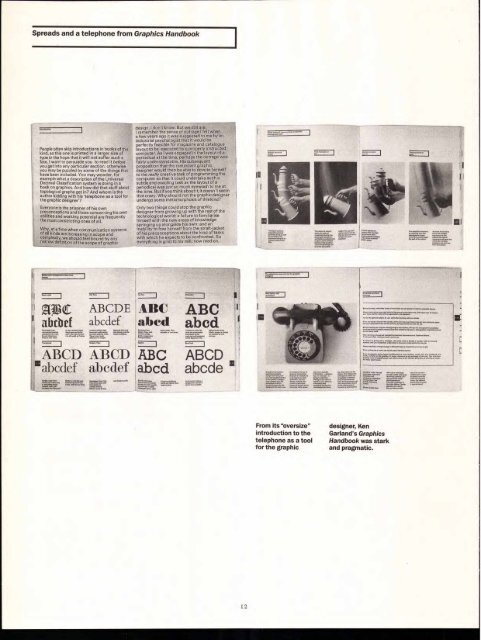You also want an ePaper? Increase the reach of your titles
YUMPU automatically turns print PDFs into web optimized ePapers that Google loves.
Spreads and a telephone from Graphics Handbook<br />
People often skip introductions in books of this<br />
kind, so this one is printed in a larger size of<br />
type in the hope that it will not suffer such a<br />
fate. I want to persuade you to read it before<br />
you get into any particular section; otherwise<br />
you may be puzzled by some of the things that<br />
have been included. You may wonder, for<br />
example what a description of the Universal<br />
Decimal Classification system is doing in a<br />
hook on graphics. And how did that stuff about<br />
topological graphs get in? And whom is the<br />
author kidding with his 'telephone as a tool for<br />
the graphic designer'?<br />
Everyone is the prisoner of his own<br />
preconceptions and those concerning his own<br />
abilities and working potential are frequently<br />
the most constricting ones of all.<br />
Why, at a time when communication systems<br />
of all kinds are increasing in scope and<br />
complexity, we should feel bound by any<br />
narrow definition of the scope of graphic<br />
design, I don't know. But we still are.<br />
I remember the sense of outrage I felt when<br />
a few years ago it was suggested to me by an<br />
industrial psychologist that it would be<br />
perfectly feasible for magazine and catalogue<br />
layout to be executed by a properly instructed<br />
computer. As I was engaged in the layout of a<br />
periodical at the time, perhaps the outrage was<br />
fairly understandable. His subsequent<br />
proposition that the redundant graphic<br />
designer would then be able to devote himself<br />
to the really creative task of programming the<br />
computer so that it could undertake such a<br />
subtle and exacting task as the layout of a<br />
periodical was just so much eyewash to me at<br />
the time. But if you think about it, it doesn't seem<br />
that crazy. Why should not the graphic desig ner<br />
undergo some metamorphosis of this kind?<br />
Only two things could stop the graphic<br />
designer from growing up with the rest of the<br />
technological world: a failure to familiarise<br />
himself with the new areas of knowledge<br />
springing up alongside his own; and an<br />
inability to free himself from the strait-jacket<br />
of his preconceptions about the kind of tasks<br />
with which he expects to be confronted. So<br />
everything is grist to his mill: now read on.<br />
ztjf3c AB CDE ABC ABC '<br />
abtbef abcdef abed abcd<br />
ABCD ABCD ABC ABCD<br />
'abcdef abcdef abcd abcde<br />
12<br />
°<br />
From its "oversize" designer, Ken<br />
introduction to the Garland's Graphics<br />
telephone as a tool Handbook was stark<br />
for the graphic and pragmatic.<br />
J

















